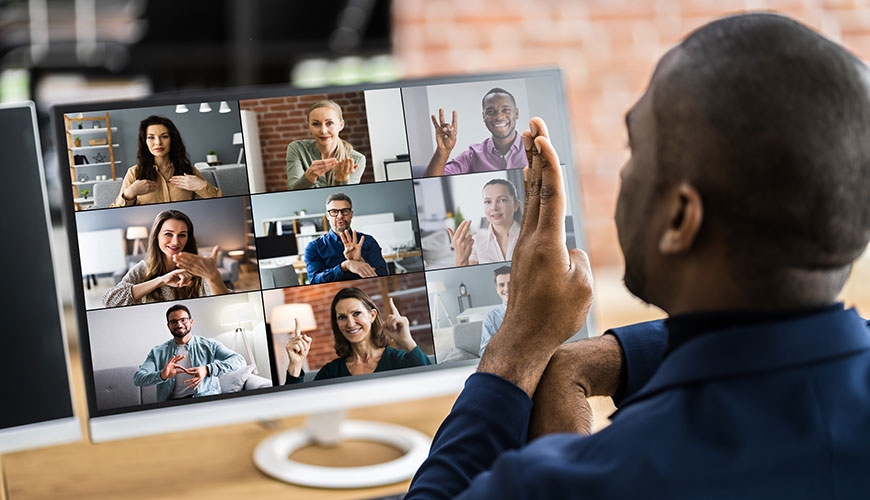Hosting accessible and inclusive online meetings and events

Download the 'Hosting Accessible and Inclusive Online Meetings and Events' PDF guide (372KB)
Download the 'Hosting Accessible and Inclusive Online Meetings and Events' DOC guide (936KB)
1. Overview
This guide has information on:
- preparing for an accessible and inclusive meeting or event
- hosting an accessible and inclusive meeting or event
- participating in a meeting or event in a way that supports accessibility and inclusivity
- enhancing and ensuring accessibility following the meeting or event.
If you are hosting an in person meeting or event please see the IncludeAbility companion guide on Hosting accessible and inclusive in-person meetings and events.
2. Introduction
Meetings that are accessible and inclusive automatically cater to the needs of a diverse audience.[1]
The COVID-19 pandemic has seen a shift from face-to-face in-person meetings to virtual meetings and events on platforms such as Google Meets, Microsoft Teams and Zoom.
These online platforms have meant that workplaces can continue to host meetings and events remotely. They have also made meetings accessible in the context of working remotely. However, as with in-person meetings and events, it is important that people with disability are able to access and participate on an equal basis.
This guide will provide you with practical steps on how to ensure your online meeting or event is accessible and inclusive for all participants.
3. Preparing for the meeting or event
Below are some practical steps that you can take to prepare for an online meeting or event that is accessible and inclusive:
- Consider the accessibility features of the platform you intend to use (for example, Skype, Microsoft Teams and Zoom) and ensure the platform is accessible to participants with a diversity of disability.
- Provide a telephone number as an alternative dial-in method for participants with no computer or internet access. This may also provide a backup in situations of poor or variable connectivity.
- Provide all participants with the agenda and meeting or event materials in their preferred accessible format prior to the meeting or event. This will allow participants who are Blind, who have low vision or who have an intellectual disability time to read over the material in advance.
- Provide the details of a contact person who can assist with troubleshooting or any access requirements prior to and during the meeting.
Invisible disability
Disability is not always visible. It is important to ensure that when preparing to host an online meeting or event you accommodate the diverse needs of your participants.
Ask all participants whether they have any access requirements prior to the meeting or event date. For instance, live captioning and Auslan interpreters may be requested by a participant who is Deaf or hard of hearing. Similarly, Easy Read material, along with a support person, may be requested by a participant with an intellectual or neurological disability.
4. Hosting the meeting or event
Below are some practical steps that you can take to host an online meeting or event that is accessible and inclusive:
- Advise participants if the meeting will be recorded.
- Depending on the size of your meeting or event, consider a roll call as a method of introducing all participants to the meeting. This practice will give participants who are Blind or who have low vision a verbal list of all attendees.
- If the meeting or event size does not allow for a roll call, request that participants announce their names prior to speaking.
- Actively manage the flow of the meeting. This may include directing participants to put questions in the chat box and calling on people to comment.
- Announce the name and the particular agenda item for each speaker.
- Nominate one person to monitor the ‘chat’ function for the online platform. The chat function allows participants to send written messages, including files, links and emojis, while the meeting is in progress. This allows participants to ask questions or request clarification, particularly those who are not able to speak. Such monitoring works well for large meetings where a lot of information is being shared.[2]
- Use accessible and plain language and ensure that the font of any text is large and easy to read with good colour contrast.
- Silence all participants or ask the participants to silence their microphone to minimise background noise.[3]
- Repeat or paraphrase any questions which may have been difficult for all attendees to hear.
- Allow time between agenda items. This not only allows for all participants to have a stretch, but also provides Auslan interpreters, captioners, note takers and support workers a break.
- Ensure that if a participant is using a co‑located Auslan interpreter, that the participant is visible on the screen and not the interpreter.[4]
- Use a virtual meeting platform which has closed captioning available. If this is not available on your chosen online platform, use a third-party provider to live caption your meeting. There is often a double benefit of this, as you will be provided a transcript of the meeting.
- Avoid using jargon, cluttered slides or flashing, strobing animations.[5]
- Describe any live scenarios, gesture, images, or any text that appears on screen to be inclusive of people who are Blind or have low vision.[6]
Ambassador reflection
Jane Spring
Chief Operating Officer, Public Service Commission NSW
IncludeAbility Ambassador
“During COVID, the ability to work remotely and to use technology has enabled me to participate more easily in a variety of forums and on an equal footing.”
5. Participating in the meeting or event
Below are some practical steps that all participants can take during an online meeting or event to support accessibility and inclusion:
- Ensure that your face is well-lit by facing a window or light. Avoid being silhouetted against the light.[7]
- Ensure that your whole face is visible including your mouth to allow participants who are Deaf or hard of hearing to lip read.
- Ensure that your name is visible on the screen.
- Remember that a participant using an Auslan interpreter may have a delayed response.
- Ensure that your audio is clear by wearing a headset to enhance the clarity of speech.[8]
6. After the meeting or event
There are further steps that can be taken by the host after the meeting or event to enhance and ensure the accessibility and inclusivity of the meeting:
- If you have recorded the meeting or event, you will usually have the ability to:
- share a captioned copy of the recording
- publish a transcript of the discussion.[9]
- Follow up with participants who requested accessibility requirements to ensure their requirements were met and to see if they have any feedback on improving the accessibility measures in place.
Endnotes
[1] Alaina Leary, ‘How to Make Your Virtual Meetings and Events Accessible to the Disability Community’, Rooted in Rights (Web Page, 13 April 2020).
[2] Jackie Leach Scully, ‘Hosting inclusive on-line meetings’ (February 2021) Disability Innovation Institute Newsletter.
[3] Jackie Leach Scully, ‘Hosting inclusive on-line meetings’ (February 2021) Disability Innovation Institute Newsletter.
[4] Jackie Leach Scully, ‘Hosting inclusive on-line meetings’ (February 2021) Disability Innovation Institute Newsletter.
[5] Alaina Leary, ‘How to Make Your Virtual Meetings and Events Accessible to the Disability Community’, Rooted in Rights (Web Page, 13 April 2020).
[6] Alaina Leary, ‘How to Make Your Virtual Meetings and Events Accessible to the Disability Community’, Rooted in Rights (Web Page, 13 April 2020) ‘How to Make Your Virtual Meetings and Events Accessible to the Disability Community’, Rooted in Rights (Web Page, 13 April 2020).
[7] Jackie Leach Scully, ‘Hosting inclusive on-line meetings’ (February 2021) Disability Innovation Institute Newsletter.
[8] Sarah Botterill, ‘How to host an accessible online meeting’, AbilityNet (Web Page, 8 January 2020).
[9] Sarah Botterill, ‘How to host an accessible online meeting’, AbilityNet (Web Page, 8 January 2020) ‘How to host an accessible online meeting’, AbilityNet (Web Page, 8 January 2020).
|
This guide is part of a suite of resources developed by the Australian Human Rights Commission as part of IncludeAbility to assist:
Explore our other Disability Employment resources. |

